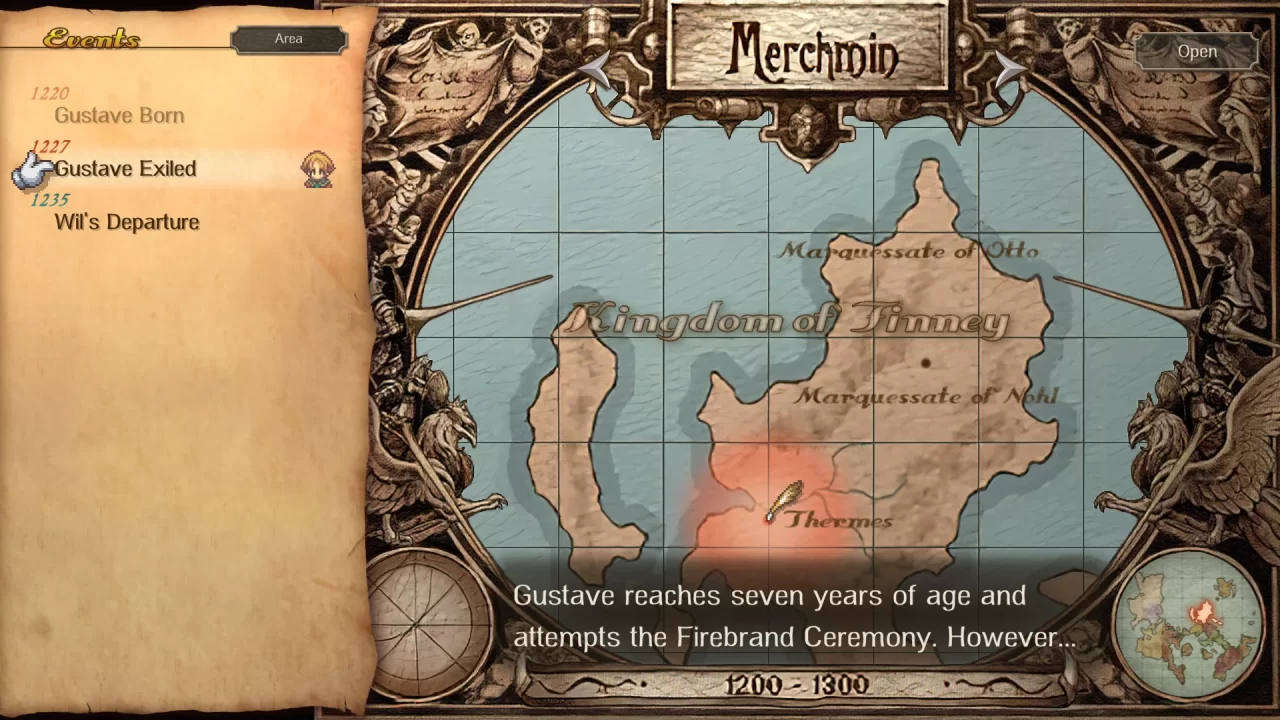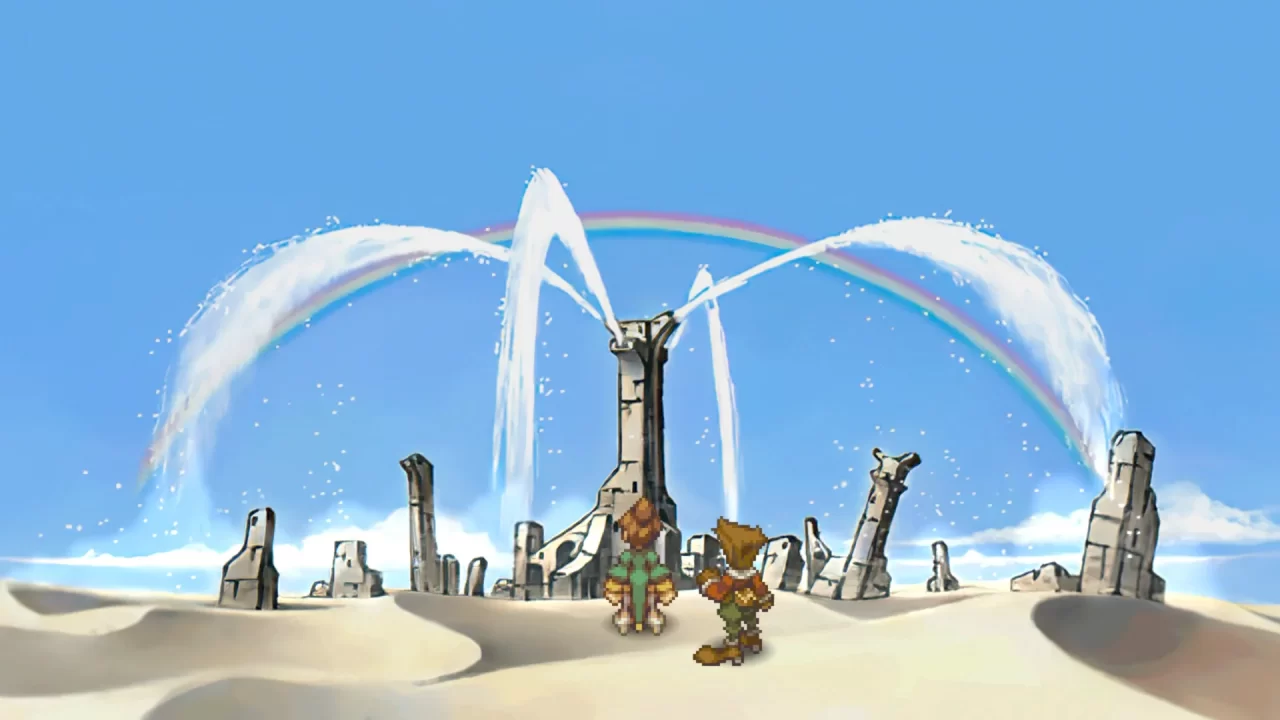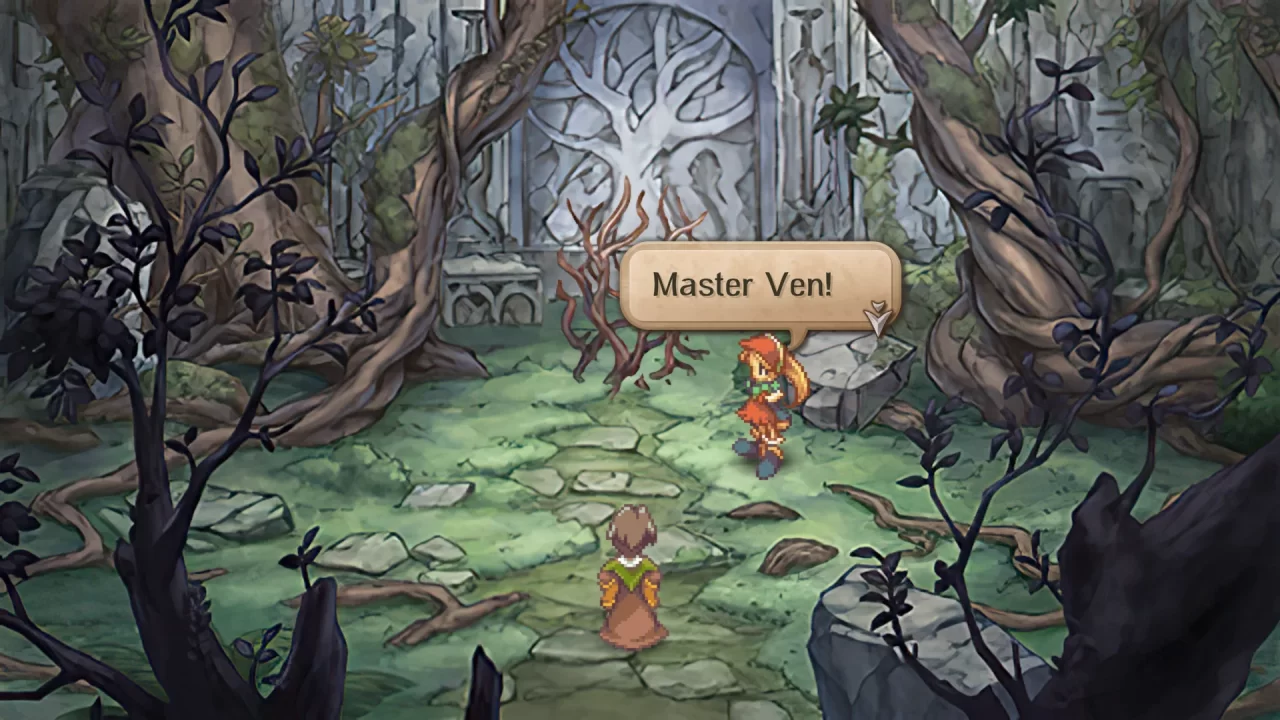In my teens, I loved SaGa Frontier 2, though objectively I knew it to be a beautiful mess. Now, 25 years later, I love SaGa Frontier 2 Remastered. It’s still beautiful, and thanks to the myriad improvements, there’s much less mess.
Before delving into the many changes Square Enix brought to this remaster, allow me to provide a summary of what this game is all about.
The Original
In the year 1220, Gustave XIII is born, a member of the royal Finney family, heir to a throne where the power to wield anima denotes power and prestige. Anima, in the SaGa Frontier 2 universe, can be understood as life or spirit and is manipulated similarly to magic. At age seven, Gustave undergoes the same trial so many of his ancestors before him: the Firebrand ceremony where the young heir holds aloft a magical flaming sword bursting with fire anima. In past generations, all goes well, and the child proves he can wield it. In some instances, the anima is too powerful and can overtake a person (we learn later that most non-royals who attempt to hold the sword burst into flames). But a surprise third option appears when Gustave XIII grabs it: nothing. The sword neither accepts him nor does it engulf him in the flames. Rather, Gustave appears to have no anima, such that his holding the sword is the same as if a lifeless object were to grasp it. This brings great shame upon the house, and Gustave’s father (Gustave XII) flies into a rage, demanding the boy be exiled, if not killed outright. Gustave XIII’s mother, Sophie, chooses to go into exile with her son to protect him from threats foreign and domestic. A handful of other servants of House Finney follow, either inspired by Sophie’s bravery or curious about the unique qualities of this non-magical Gustave.
The player navigates a series of linear stories and tutorial missions across the chronology of Gustave’s first 15 years. At that point, a completely unrelated story appears: that of the digger Wil Knights. Outside the world of royalty, nobility, and politics, there are adventurers known as “diggers” who earn a living excavating the treasures of the past. The most exciting treasures are known as “Quells,” anima-infused objects with unique properties created by ancient humanity, not well understood in present society. Wil continues in the tradition of his father, Henry Knights, in seeking out powerful Quells and taking care to keep a most powerful and dangerous Quell, simply known as “The Egg,” from falling into the wrong hands. Actually, anyone’s hands, as we quickly learn that The Egg has a will of its own and, once latched onto a human, starts to make its own plans.
From here, the game presents a series of vignettes, mission-based stories either on the Gustave side or the Knights side, spanning from 1220 to 1305, when everything comes to a head, and we finally see how the fate of Gustave’s ancestors and the Knights family fully weaves together. From a selection menu at the end of each chapter, the player gets a handful of options. Essentially, it comes down to “continue the Gustave path,” “continue the Knights path,” “check out this side story,” or “do some free-roaming in one of the towns you’ve visited in previous stories.”

Since the day it was first revealed in 1999, SaGa Frontier 2 has been celebrated for its aesthetics. Nearly every piece of background art was sketched and colored with a watercolor style. The music, from a then lesser-known and now widely-celebrated Masashi Hamauzu, maintains an impressionist style with a distinct chamber music approach. As for its gameplay, the combat system is largely the same as what you’d find in past SaGa titles. You have physical and magical capabilities, categorized by various types, and new skills to learn under each through the “glimmer” system. Things get a little more complicated in SaGa Frontier 2 with the large, ever-rotating cast of characters needing to relearn and/or reassign skills based on their greatest proficiencies. I would be remiss if I ignored that, alongside the typical combat classes (sword, spear, axe, etc), the magical classes are based on the six anima types: tree, stone, flame, water, tone, and beast. These six anima appear to have a material origin, and as such, a seventh man-made material (steel) acts as a sort of anti-anima and becomes the preferred material for Gustave XIII.
Combat also comes in three forms. Alongside the party-based battles typical of SaGa (notably, party size changes from five to four in this game), there are also the occasional grid-based Tactics battles for some of the clashes of kingdoms throughout the game. Finally, there is the “duel” system, where one party member can face off against a single foe and manually select specific actions for their weapon or magical art, hoping to discover new techniques or else having to memorize the commands for previously known techniques to utilize. It’s a complicated system.
The original SaGa Frontier 2, boasting all of these features, made for a memorable experience, but one marked also by the frustrations of oft-changing party members with reset stats, rare equipment lost from one generation to the next, the possibility of soft-locking within a scenario too difficult for the characters to complete, and so much more. As I said before: it may have been beautiful, but SaGa Frontier 2 was a mess to play.
Then, in March 2025, Square Enix decided to resolve virtually everything about that mess in a shadow-drop remaster that quickly captured my heart.
The Remaster
Let’s start with the obvious: everything in the “Quality of Life” realm that applied to the first SaGa Frontier Remastered (from 2021) applies here. Players can manipulate exploration and combat speed with ease. Quicksaves and autosaves minimize punishment for failure. An “exit event” option prevents soft-locks for underdeveloped characters. In-game documentation explaining the nature of the combat system helps to demystify it. This first step was a necessary one to make the game marketable in this day and age. But they really did a great job here. Any failures or frustrations I experienced this time around? They were mine to own. In 2000, on PSOne, far too many failures that I experienced were a result of poor design.
Beyond the QoL improvements, Square Enix did plenty more to improve the base game. First and foremost is the new story content. There are about ten new events to find during a play through the main game. Some of these events are dialogue-only, but most of them include a mission with exploration, combat, and puzzle-solving. From a storytelling perspective, these new chapters help to flesh out some of the formative events for major characters, and in other cases help to establish origin stories for secondary characters. Perhaps most significantly, they give backstory to all six of the Edelritter that serve “fake Gustave” in the endgame scenario. In the original game, we only got a clear look at one of them (Sargon).
Additionally, after clearing the game, there are two epilogue chapters: one with combat, and one as a simple story epilogue. These chapters appear after clearing the final missions in 1305, but they occur about 40 years prior, as they unveil a hidden truth about Gustave XIII and what was believed to be his final battle.
Visually, there isn’t much new to talk about. There are some new designs for added enemies, though they’re often just palette swaps of existing enemies. What’s most important is that the beautiful, hand-crafted watercolor backgrounds are intact. I think this is noteworthy, given the present discourse about AI-generated art and its potential use in games.
However, with these beautiful backgrounds, there remains one dreadful flaw: navigating every single screen. I found this more troubling now than when I played the original 25 years ago. Granted, that may have begun because I was so frustrated with combat and growth systems that I paid less attention to how hard it was bumbling around atop a flat background with loosely mapped floors and walls. The fact that it is as good as it is, honestly, is still praiseworthy. Mapping collision on a bunch of watercolor stills probably isn’t all that easy, and I’m sure it went through several QA passes back in the day. I think it could have used going through a few more QA passes now. But at the end of the day, it comes down to your own eyes getting used to what is floor, what is wall, what is ladder, etc.
On to the music! When SaGa Frontier Remastered launched, the restored content and new Fuse chapter allowed Kenji Ito the opportunity to write a few new songs for the game, keeping the music in the soundfont and limitation of the sequenced MIDI audio used on the PlayStation. We have a similar story here, though I’m not entirely sure if the new tracks are all Masashi Hamauzu’s doing or if someone else stepped in for the new tracks. I say that because, largely, the new music written for the additional scenarios and ultra-hard optional boss battles are basically new arrangements, variations on themes, of previous tunes. Granted, that’s essentially what the entire SaGa Frontier 2 Original Soundtrack already was. Presently, I am curious as to what I may have missed or if there will be additional arrangements on the recently announced four-disc Remaster soundtrack! Disc four is set aside for all the new tunes, so I guess we’ll see just how much is there when it drops in July!
I hinted earlier that there are super-bosses as optional postgame content. I’ll be honest: I managed to take down one and then stopped so I could write this review. I will go back to conquer the others. These are fun additions to the game. Thanks to the inheritance system for stat carry-over (similar to the Romancing SaGa 2: Revenge of the Seven remake), I was able to reach the game’s final boss in about 20 hours. In my Y2K playthrough, I think it took me 40 hours to reach the final boss, and another 10 hours of grinding, and failing, before I finally cleared the base game. The lower time commitment in this new playthrough incentivizes players (like myself) who enjoyed the new growth options to further optimize their party for the divine beasts of each of the six anima types, as well as the super-hard “true final boss” battle.
One last little thing: a Japan-only accessory called the “PocketStation” had some minigame features for a handful of Squaresoft titles, including SaGa Frontier 2 and Final Fantasy IX. The minigame here, a passive “digging” minigame where you assign NPC diggers you’ve recruited to various locations to find new tools, adds an extra layer of opportunity for players to find high-quality equipment in larger quantities and earlier than what was typical.
The Conclusion
I know myself and I know my pro-SaGa bias well enough to stop myself from throwing all 100s and an Editor’s Choice award at this Remaster. While SaGa Frontier 2 Remastered is a massive improvement over the original, and well worth playing, I remain cognizant of its flaws. The story is highly interesting and definitely fun to dive into, pondering to oneself, “What isn’t being told? What other dynamics are at play?” And yes, the new localization makes the plot far easier to comprehend. But there is a sparseness to the story’s presentation. Nearly 100 years pass and we’re just getting snapshots, vignettes for a handful of characters. That might be a little thin for players who prefer dialogue-heavy RPGs. This ain’t that.
Put that alongside the seemingly insurmountable problem of mapping the playable character’s sprite on the 2D backgrounds, and I’m left admitting this isn’t the perfect game. It may end up being my personal favorite pick of 2025, but I also acknowledge that for many an RPG fan, SaGa Frontier 2 Remastered may serve, at best, as an interesting distraction or holdover for an upcoming AAA title, and that’s okay too.





